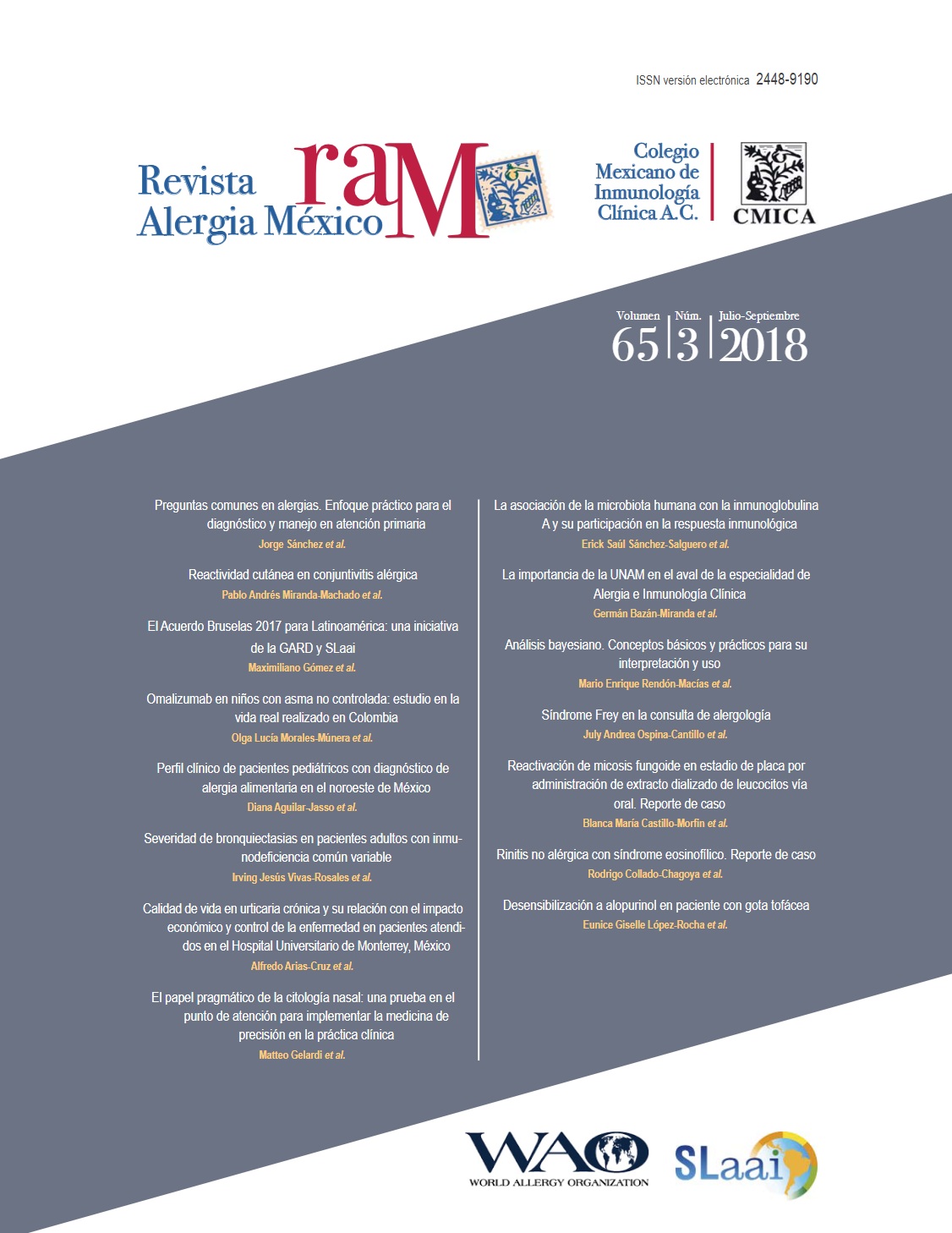Abstract
Background: Precision medicine is an up-to-date strategy aimed at individualizing precise pathophysiological mechanisms. Thus, precision medicine is the basis for personalized medicine, inasmuch as it seeks to define the most appropriate treatment for each patient. Nasal cytology requires only an optical microscope, stains, glasses, and nasal cytology curettes. The procedure may last very few minutes using quick staining and, therefore, it can be considered a reliable point-of-care test in the office setting.
Methods: Cross-sectional study that included 5030 outpatients with nasal disorders: 2612 males and 2418 females, with a mean age of 36.8 ± 17.1 years, who were attended to within a 5-year period. The patients were subdivided according to skin prick-test and nasal cytology results into subjects with allergic rhinitis or non-allergic rhinitis. Cellular forms were further subdivided based on their cytotype: NARNE (> 50% of neutrophils with absence of spores and bacteria); NARES (> 20% of eosinophils); NARMA (> 10% of mast cells); and NARESMA (> 20% of eosinophils and > 10% of mast cells).
Results: 453 subjects (9%) had negative nasal cytology, 1056 (21%) had allergic rhinitis, 538 (10.7%) had NARES, 493 (9.8%) had nasal polyposis, 251 (5%) had rhinosinusitis, 221 (4.4%) had NARESMA 201 (4%) had infectious rhinitis, 131 (2.6%) had NARMA, 89 (1.8%) had NARNE, with the remaining subjects having a miscellaneous inflammatory/infectious profile.
Conclusions: Nasal cytology provides quick information about phenotype and endotype and can be repeated during follow-up to assess post-treatment changes.
References
Hellings PW, Klimek L, Cingi C, Agache I, Bachert C, Bousquet J, et al. Non-allergic rhinitis: position paper of the European Academy of Allergy and Clinical Immunology. Allergy. 2017;72:1657-1665. DOI: 10.1111/all.13200
Jacobs RL, Freedman PM, Boswell RN. Nonallergic rhinitis with eosinophilia (NARES syndrome). Clinical and immunologic presentation. J Allergy Clin Immunol. 1981;67(4):253-262. Available at: https://www.jacionline.org/article/0091-6749(81)90019-1/pdf
Gelardi M, Maselli-Del-Giudice A, Fiorella ML, Fiorella R, Russo C, Soleti P, et al. Non-allergic rhinitis with eosinophils and mast cells constitutes a new severe nasal disorder. Int J Immunopathol Pharmacol. 2008;21(2):325-331. DOI: 10.1177/039463200802100209
Gelardi M, Fiorella ML, Russo C, Fiorella R, Ciprandi G, et al. Role of nasal cytology. Int J Immunopathol Pharmacol. 2010;23(1 Suppl):45-49.
Hellings PW, Fokkens WJ, Bachert C, Akdis J, Bieber T, Agache I, et al. Positioning the principles of precision medicine in care pathways for allergic rhinitis and chronic rhinosinusitis-a EUFOREA-ARIA-EPOS-AIRWAYS ICP statement. Allergy. 2017;72(9):1297-1305. DOI: 10.1111/all.13162
Duarte HA, Panpradist N, Beck IA, Lutz B, Lai J, Kanthula RM, et al. Current status of point-of-care testing for human immunodeficiency virus drug resistance. J Infect Dis. 2017;216(Suppl 9):S824-S828. DOI: 10.1093/infdis/jix413
Schols AMR, Stakenborg JPG, Dinant GJ, Willemsen RTA, Cals JWL. Point-of-care testing in primary care patients with acute cardiopulmonary symptoms: a systematic review. Fam Pract. 2018;35(1):4-12. DOI: 10.1093/fampra/cmx066
Wilkes MS, Day FC, Fancher TL, McDermott H, Lehman E, Bell RA, et al. Increasing confidence and changing behaviors in primary care providers engaged in genetic counselling. BMC Med Educ. 2017;17(1):163. DOI: 10.1186/s12909-017-0982-4
Gelardi M, Iannuzzi L, De-Giosa M, Taliente S, De-Candia N, Quaranta N, et al. Non-surgical management of chronic rhinosinusitis with nasal polyps based on clinical cytological grading: a precision medicine-based approach. Acta Otorhinolaryngol Ital 2017;37(1):38-45. DOI: 10.14639/0392-100X-1417
Gelardi M, Quaranta N, Passalacqua G. When sneezing indicates the cell type. Int Forum Allergy Rhinol. 2013;3:393-398. DOI: 10.1002/alr.21119
Gelardi M. Atlas of nasal cytology. Italy: Edi Ermes; 2012
Meltzer EO, Jalowayski AA. Nasal cytology in clinical practice. Am J Rhinol. 1988;2:47-54.

This work is licensed under a Creative Commons Attribution-NonCommercial 4.0 International License.
Copyright (c) 2018 Revista Alergia México





